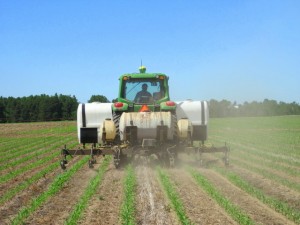The practice of adding nitrogen fertilizers to cropland has historically been an inexact science because of the complexity of the nitrogen cycle. Over the course of the year nitrogen can have many forms, and testing before planting will not accurately represent how much nitrogen will be available to plants when they need it most. This cycling of nitrogen also means that nitrogen applied from manure and legume cover crops before planting might be lost from the soil during the spring, creating a high demand later in the season. Sidedressing a crop during the summer can fulfill this demand but it is important to know how much to apply. A Pre-Sidedress Nitrogen Test (PSNT) can help determine this amount.
How To Sample
To determine the amount of nitrogen in the soil and the amount that needs to be added, soil samples must be taken. It is best to do this about 5-14 days before sidedressing so the samples are as accurate as possible while also allowing time for the results to be returned before your sidedress date. Ten to twenty, 12 inch soil samples, should be taken from the field, avoiding areas that are atypical. Testing areas should be consistent in terms of manure application history, crops, and soil type. These samples should be mixed together, immediately dried, and after drying delivered to a soil testing lab as soon as possible to ensure accurate results. Time, temperature, and wetness are all factors that can change the form of nitrogen, skewing results.
Which Fields are Appropriate to Test?
The test is most useful for fields that have manure application or legume crop history since these fields will have higher organic matter, the form in which nitrogen availability is the most uncertain. Fields planted in corn and other nitrogen demanding crops should be tested. This test is not accurate if large amounts of fertilizer have been broadcasted over the field. Starter bands of fertilizer should be avoided during soil sampling.
Interpreting the Results
Research has shown that when the soil nitrate-N level is above 21 ppm, there is little chance of an economic
response to adding additional N to the field. At soil nitrate- N levels below 21 ppm, sidedress N will be required to achieve optimum economic yield. The equation for determining the amount of nitrogen to sidedress can be found on the Penn State Ag Extension website HERE
Programs
USDA NRCS
USDA NRCS administers a variety of cost share programs to implement conservation practices such as stream bank fencing. The Conewago is USDA’s “Showcase Watershed” meaning the watershed is targeted for resources and funding.
319 Funding
Farms in priority areas of the watershed may also be eligible for funding through the County Conservation Districts’ 319 funding.
BMP Challenge
American Farmland Trust offers compensation for any yield loss resulting from implementing this and other nitrogen reduction practices
Interested in implementing this practice?
Contact:
Heather Grove, USDA NRCS
(717) 874-2530, heather.grove@pa.usda.gov
Eric Naguski, DCCD
(717) 921-8100, enaguski@dauphinc.org
Web Resources
Pre-sidedress Soil Nitrate Test for Corn
For a printable version of this information-
PSNT Factsheet

